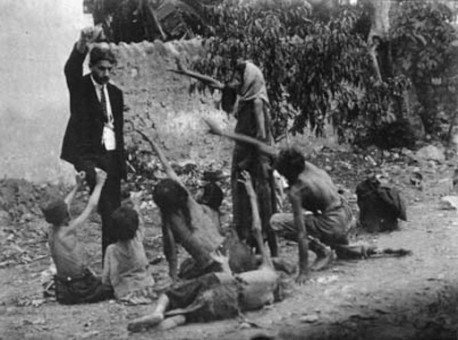. I would like take this opportunity to tell you the following point. From 1921 to 1965-1972, the international leadership of the ARF was based in Boston, US. After 1944, the pro-Nazi tendancy of the ARF was substituted by a conservative and pro-American leadership. But the ARF was discredited for many years, after the pro-Nazi compromission, but also the serie of political assassinations, from 1918 to 1933 https://armenians-1915.blogspot.com/2009/01/2694-chronological-list-of-armenian.html), which culminated with the assassination of archibishop L. Tourian ().
The Hunchakian Party and the Ramkavar Party were discredited to, by their support to the Stalin programm of ressettlement of Lebanese-Armenians in Soviet Armenian, from 1945 to 1948. As early as 1945, Stalin denounced the friendship treaty of 1921, and asked Kars and Ardahan district to Turkey for Soviet Armenia (http://www.eraren.org/index.php?Lisan=en&Page=DergiIcerik&IcerikNo=110). It was probably the first event of the Cold War. Thanks to US support, Turkey could refuse Soviet claims. Hunchak and Ramkavar failed. The anti-Communist era in USA was surely not favourable to their activities.
In 1957, as a final result of Tourian’s assassination, there was a schism in the Armenian church. The ARF, for its surviving, turn to Lebanon in the late 1950’s: the big Armenian community in this country is the last chance.
During the 1950’s, the Soviet services changed of name (KGB) and priorities: the most important mission was now the intelligence in foreign coutries (like CIA), not the counter-intelligence (like FBI) and the political police. One of the mission of the KGB, during the late 1950’s, the 1960’s and the 1970’s was turn the ARF, for have again a strong Armenian tool. Syria was an ally of the USSR, and the Lebanon, an openfield for the Syrian secret services.
During the 1950’s, the Soviet services changed of name (KGB) and priorities: the most important mission was now the intelligence in foreign coutries (like CIA), not the counter-intelligence (like FBI) and the political police. One of the mission of the KGB, during the late 1950’s, the 1960’s and the 1970’s was turn the ARF, for have again a strong Armenian tool. Syria was an ally of the USSR, and the Lebanon, an openfield for the Syrian secret services.
Why this manipulation? The “Eisenhower doctrine” (which failed) pointed the importance of the Near East for the Cold War. After the death of Stalin, some agreements (about Austria in 1955, and others later), the Cold War became less direct. In 1961, the rocket crisis demonstrated the strategic importance of Turkey, single member of NATO wich had a large boundary with USSR. In 1963, after four years of negociations, Turkey signed an association agreement with the European Economic Community, with a perspective of full adhesion (like Greece in 1961). The Russians were always hostile to any European unification.
During the first half of the 1960’s, the Eichmann trial had as consequence a new, and more important, interest for the Shoah studies: publication of The Destruction of the European Jews, by Raul Hilberg in 1961, in USA; of Auschwitz, by Léon Poliakov, in 1964, in France; many university grants; etc. It was in this period that the word genocide started to be used frequently in the scholar, and even ordinary, language; and as all the other words frequently used, it was devalued, like fascism before.
The invention of the “Armenian genocide”, in 1965, was almost openly a fabrication of the Soviet propaganda, against a member of NATO, candidate to the EEC. It was also the single way for the survival of the “diaspora”, and especially the nationalist parties.
As a coincidence, Waddi Haddad, father of the contemporary terrorism, who recruited Hagop Hagopian and strongly influenced the ASALA, was a agent of the KGB since 1971.
As a coincidence too, Tessa Hofman, Greek-German, one of the most famous supporter of Armenian claims in Western Europe, was a member of the so-called “tribunal” of 1984, who caracterised the events of 1915-1916 as “genocide”. This “tribunal” is the suite of the so-called “Russel tribunal”. Very interesting accounts about the “Russel tribunal” are in Guenter Lewy, America in Vietnam, New York-Oxford, Oxford University Press, 1978. In 1967, the “tribunal” caracterised the US action in Vietnam as “genocide”. The “tribunal” was infiltrated by pro-USSR and pro-Vietmin personalities.
The choice of the return to terrorism by the ARF, in 1972, was directly linked with the collapse of the pro-American leadership, which was replaced by a pro-Soviet leadership, during the Cold War. The general staff of the ARF came from Boston to Beyruth.
The choice of the return to terrorism by the ARF, in 1972, was directly linked with the collapse of the pro-American leadership, which was replaced by a pro-Soviet leadership, during the Cold War. The general staff of the ARF came from Boston to Beyruth.
As a result, the actions of the ARF since the 1970’s were on the Russian line, and support Russian interest. The collapse of USSR changed nothing. In your opinion, why the European dashnak defamed recently as “denialist pipe-line” the Nabucco pipe-line, which will permitt to the EU to be less dependent of Russia for gas? Why ASALA threatened, in 1993, the US companies which were building the pipe-line Baku-Tbilissi-Ceyhan?
The ATAA pointed correctly that the rise of the PKK started short after the decline of Armenian terrorism. But they did not go after the argument. The PKK, even more than the ASALA and Dashnak JCAG terrorist group, was a Russian/Syrian product. Thanks to the financial support from the “diaspora”, drug smuggling and cooperation with other terrorist groups, like PFPL and Carlos, Hagopian was not completely dependent of Soviet and Syrian support. The ASALA staff came, around 1980, from Syria to Greece. The Soviet and the Syrian did not make the same error with PKK. Öcalan had not the permission to go out of Syria until 1998 and the end of the PKK-Syria alliance. So, he was permanently under the monitoring of Syrian and Russian secret services.
Best regards,
KM


Leave a Reply